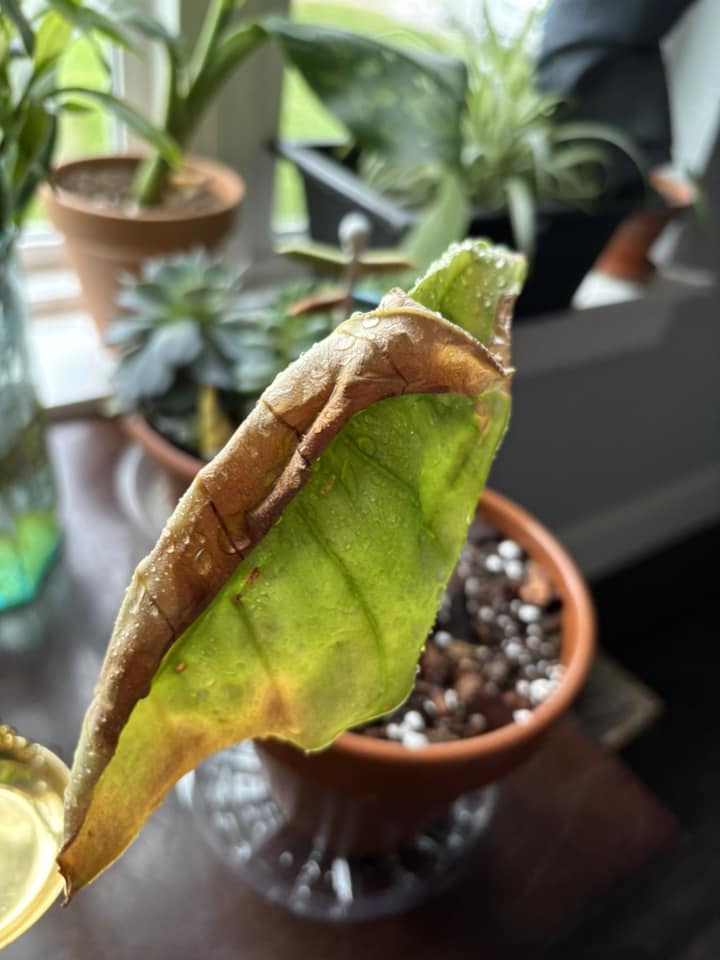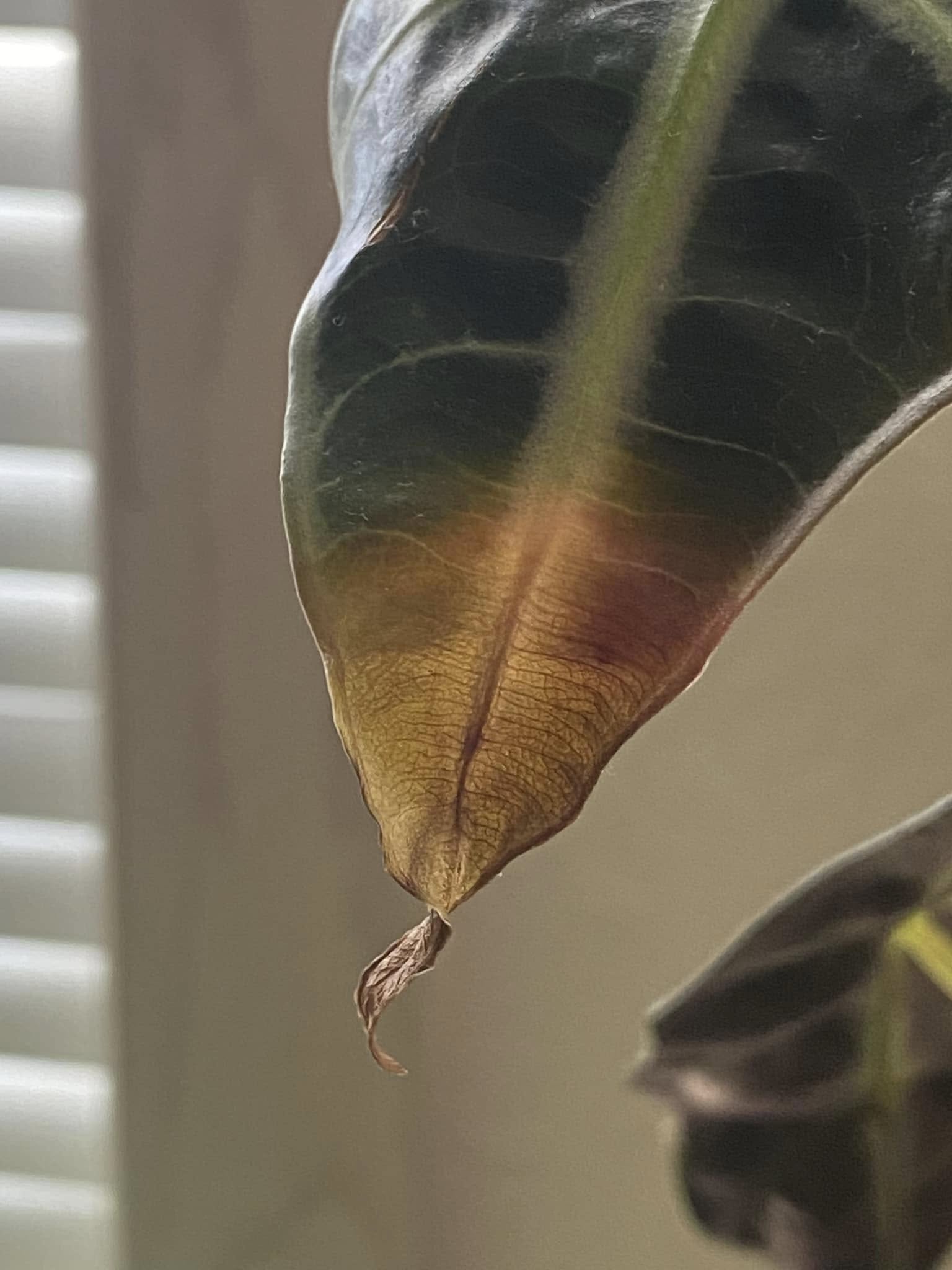
Alocasia plants are prized for their stunning, tropical foliage. However, if you’ve noticed brown leaves appearing on your Alocasia, you might be wondering what’s going wrong. Browning leaves can be alarming, but don’t worry—this issue is common and often fixable.
Understanding the reasons behind browning leaves is key to ensuring your Alocasia remains healthy and vibrant. In this guide, we’ll explore the possible causes of leaf browning and provide actionable solutions to revive and maintain your plant’s beauty.
I’ve provided detailed information in the article below to help with your concerns, However, if you still have questions or need more help, feel free to share photos of your plants or describe your issue on our Facebook Group. Just join the group and leave a comment on the most recent post — either I or someone from the community will respond as soon as possible. We also share helpful and unique plant care tips daily, so consider joining the group to stay updated!
Why Are My Alocasia Leaves Turning Brown?

Knowing the cause of browning leaves is the first step in solving the problem. Here are some of the most common reasons:
1. Overwatering or Underwatering
Watering issues are one of the leading causes of brown leaves in Alocasia plants.
- Overwatering: When the soil remains too wet for extended periods, the roots can suffocate, leading to root rot. Affected roots are unable to transport nutrients effectively, causing the leaves to turn brown and mushy. Over time, the plant may wilt and struggle to survive.
- Underwatering: On the other hand, if the plant is not receiving enough water, it cannot maintain proper hydration. Dry soil will cause the leaves to become crispy, brittle, and brown, particularly at the edges and tips.
How to Fix It:
- Water your Alocasia only when the top 1-2 inches of soil feel dry. Check the moisture level by inserting your finger into the soil.
- Ensure your pot has drainage holes to prevent water from accumulating at the bottom.
- Use a well-draining potting mix containing peat moss, perlite, or orchid bark to maintain the right moisture balance.
- If you suspect overwatering, reduce the frequency of watering and check for root rot. If rot is present, trim affected roots and repot in fresh soil.
2. Low Humidity Levels
Alocasia plants originate from tropical rainforests, where humidity levels are high. When placed in environments with dry air, their leaves lose moisture quickly, leading to brown edges and tips.
How to Fix It:
- Increase humidity levels: Use a humidity tray by placing a shallow dish filled with pebbles and water beneath the plant. As the water evaporates, it will raise humidity around the plant.
- Misting: Lightly mist the leaves with water a few times a week. Be careful not to overdo it, as excessive moisture on leaves can encourage fungal infections.
- Use a humidifier: The most effective way to maintain consistent humidity is to use a humidifier, keeping levels above 60%.
- Group plants together: Placing multiple plants close to each other creates a microclimate with higher humidity.
3. Too Much Direct Sunlight
Alocasia plants thrive in bright, indirect light. Exposure to intense, direct sunlight can scorch their delicate leaves, resulting in brown, dry patches.
How to Fix It:
- Relocate your plant: Place it in a bright room but away from direct sunlight, such as near an east-facing or north-facing window.
- Use sheer curtains: If your plant is near a sunny window, use sheer curtains to diffuse harsh sunlight.
- Rotate the plant: If only one side is getting light, rotate the plant every few days to ensure even exposure and prevent scorching.
4. Nutrient Deficiency
Lack of essential nutrients can weaken your Alocasia, leading to brown or yellowing leaves. Key nutrients such as nitrogen, potassium, and magnesium play a crucial role in maintaining leaf health.
How to Fix It:
- Use a balanced liquid fertilizer: Feed your plant once a month during the growing season (spring and summer) with a fertilizer containing nitrogen, phosphorus, and potassium.
- Avoid over-fertilizing: Excess fertilizer can accumulate in the soil as salt deposits, causing root damage. Flush the soil occasionally with plain water to remove excess salts.
- Supplement with organic compost: Adding organic compost or worm castings can enhance soil fertility and provide slow-releasing nutrients.
5. Pests and Diseases
Common pests like spider mites, aphids, and mealybugs suck the sap from Alocasia leaves, weakening the plant and causing brown spots or curling.
How to Fix It:
- Inspect your plant regularly: Look under the leaves and along the stems for signs of pests.
- Use neem oil or insecticidal soap: Spray affected areas with neem oil or insecticidal soap to eliminate pests.
- Keep the plant clean: Wipe the leaves with a damp cloth to remove dust and prevent pest infestations.
- Isolate infested plants: If you have multiple plants, isolate the affected one to prevent pests from spreading.
6. Temperature Stress
Alocasia plants are sensitive to extreme temperature fluctuations. Cold drafts, sudden temperature drops, or excessive heat can cause stress, resulting in leaf browning.
How to Fix It:
- Maintain stable temperatures: Keep the plant in a room where temperatures range between 65–80°F (18–27°C).
- Avoid placing it near air conditioners or heaters: Cold drafts from AC vents and hot air from heaters can shock the plant.
- Move it away from drafty windows: During winter, relocate your Alocasia away from cold windows to prevent stress.
7. Natural Aging Process
Sometimes, leaf browning is part of the plant’s natural cycle. Older leaves may turn brown and die off to make room for new growth.
What to Do:
- Trim off old or damaged leaves: Use clean scissors to remove fully browned leaves.
- Monitor new growth: If the plant continues to produce healthy new leaves, there’s no need for concern.
- Focus on overall plant care: Maintain proper watering, lighting, and humidity levels to ensure overall health.
How to Save a Browning Alocasia Plant
If your Alocasia is already showing signs of distress, follow these steps to revive it:
Step 1: Identify the Issue
Examine your plant’s leaves, soil, and environment to determine the cause of the browning.
Step 2: Adjust Watering Habits
Ensure you’re watering appropriately based on your plant’s needs.
Step 3: Improve Humidity
Increase humidity levels around your plant if dry air is the problem.
Step 4: Relocate the Plant
Move your plant to a spot with bright, indirect light and stable temperatures.
Step 5: Treat Pests Immediately
Use neem oil or insecticidal soap if pests are present.
Step 6: Fertilize Wisely
Provide balanced nutrients without overdoing it.
Step 7: Trim Damaged Leaves
Cut off any fully browned leaves to help your plant focus on new growth.
